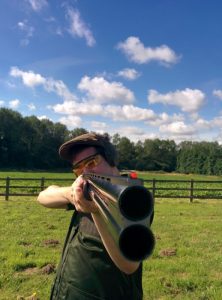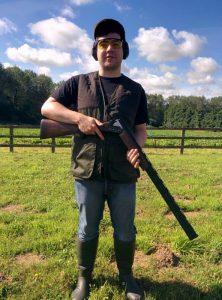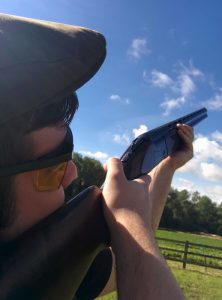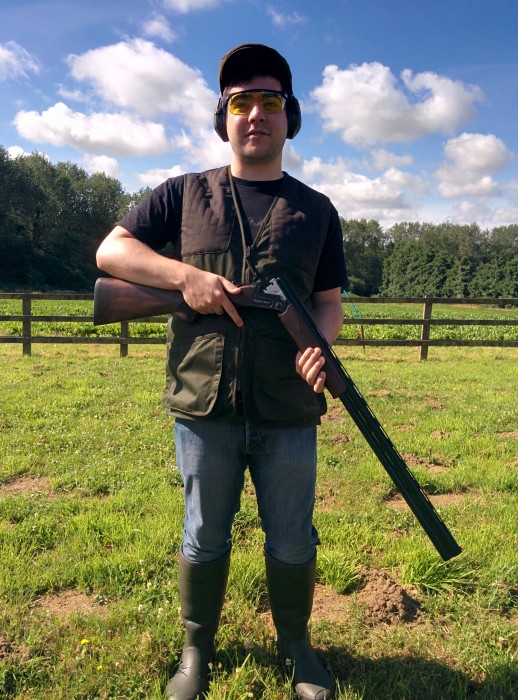
With a summer full of sporting events ahead, skeet shooting and trap shooting will once again be featured prominently on TV and online, and will hopefully help to publicise these fast growing sports and inspire a new generation of shooters to take part. If you are looking to compete on the global scale you are first going to have to master the basics.
This is somewhat of general guide to the various clay shooting disciplines, how to prepare yourself for each and some of the different techniques and target shooting supplies you will require to start shooting like a pro.
Know Your Game
So there are three different distinct styles of shooting clay pigeons but how are you meant to know which one is for you?
Trap shooting involves shooting a target that is launched from a single house that is located away from the shooter. This is the sport people generally think of when clay pigeon shooting is mentioned and this is one that tests accuracy and consistency above all else.
Skeet shooting involves two targets that are launched so that their paths cross in front of the shooter and are shot, usually with an over and under shotgun, in quick succession. The challenge here is a test of reflexes as well as accuracy and how quickly one can set their sights on a second target after shooting the first.
The third discipline is sporting clays which is sometimes “golf with a shotgun” and while maybe not quite as exciting as this name makes it sound, it involves a long course with various houses launching targets over natural terrain. It is considered great practice for live game shooting but is often not as competitive as the other two.
All three disciplines require slightly different attributes from their shooters and the best way to decide which one is for you is to try them!
Keep it Legal
Before you can buy a shotgun, or cartridges, you need to get yourself a shotgun license. These are obtained through your local police force and will cost £79.50, £49 for renewals*, and are straightforward and simple to fill out.
Recently the law was changed so that anyone can countersign your application as long as they have known you for two years and they no longer have to belong to a “listed” profession. Our comprehensive guide on this process can be found here. You can learn more elsewhere on our blog by heading here to our post ‘How To Get A Shotgun Licence’.
Unless you own your own clay thrower and a significant piece of land you are also going to need to join a local shooting club. Luckily there are plenty of these located all over the country and are often populated with friendly individuals that are more than happy to share their knowledge.
* Figures correct as for July 2016
The Right Tool
There are essentially 5 types of shotgun, single barrel: classic break barrel that must be reloaded after each shot, over and under: similar to the single barrel but has 2 barrels that are located on top of each other, side by side: the classic double barrelled shotgun where the barrels are next to each other, pump action shotguns and semi-automatics.
Any and all shotguns can be used for skeet and trap shooting but over and under as well as semi-automatics seem to be the most common as pump actions require significant movement to load the next shell which can throw off your aim whilst side by side shotguns have barrels next to each other meaning one shell shoots slightly left, and one slightly right. Single barrel shotguns are also effective but have to be reloaded after every shot making them unsuitable for skeet shooting. You can have a look at our range of shotguns here.
It’s also vital to grab the right target shooting supplies to go with your gun. When it comes to gauge selection there is some debate between 12 gauge and 20 gauge. Most people seem to be of the idea that more shot inside the shell increases the chance of hitting clays therefore 12 gauge are the way go. I am of the opinion that having a shotgun that you can shoot comfortably is the most important factor in accuracy, and besides you can get 20 gauge shells that are as heavy, if not heavier, than some 12 gauge shells.
Gauge does not always equal weight. When Skeet shooting I think that 20 gauge shells are actually more effective as they often have less recoil, keeping you on target for the second clay. Our shotgun cartridge to buy are available here.
It is worth noting that if using a semi-automatic or pump action shotgun that has a capacity higher than 3, you will need a fire arms (FAC) license and not just a shotgun certificate to hold them legally. Head to the .Gov.uk site for more.
Prep Work
Practice probably makes perfect but proper preparation prevents poor performance. This saying, if you can actually say it, will stand you in good stead when shooting as everything should be

considered if you want the best results. As well as your shotgun and cartridges you are going to need to consider which ear defenders are suitable, is your shooting outfit suitable for the weather? What are you going to have for lunch?
Everything, except maybe your sandwiches, is going to affect your shooting in a small way so it is important to get everything right. All of this is also best laid out the night before so you feel well prepared when you wake up and can focus on the task at hand instead of scrambling around, counting cartridges or wondering where the hell you put your shotgun certificate. This kind of prep work particularly important if you are entering a shooting competition, as you are going to be full of adrenaline as it is and the cooler you can keep your head, the better you will perform.
Clothing is important as weather conditions and body temperature can have a significant effect on performance, so make sure you choose a suitable shooting jacket and sturdy footwear. Perhaps most important of all is your ear and eye protection. Shotguns are LOUD and you are going to want to protect yourself if you want to hear anything in the years to come. Have a look at our great of range of ear defenders here.
Pull!

Watch the clay! I can’t stress this enough, you’d be surprised the amount of times I’ve heard things like “those clays were so fast they caught me off guard” or “I wasn’t expecting them to come from there”. Well the trick to countering this is to watch every, single, clay and analyse it. From this you can determine where the best place to take your shot is, usually when the clay starts to slow, and from this improve your score card.
Before you start shooting you will be shown where that targets are coming from and how they fly through the air. Keep track of their flight path and particularly note where they slow down and/or change direction, as this will be your best chance to hit them.
Now every clay is not going to fly exactly the same but by a law of averages, you can have a pretty good idea of where the clay is going to move before it does. This process is called “reading” the clay and being able to do this effectively is what makes between a good shooter and a winning shooter.
A small point about your eyes. It is worth shooting with both eyes open if you can as you can benefit from a wider field of view but if you prefer to shoot with one eye closed you want to be using your dominant eye. 80% of men have a dominant right eye whilst around 80% of women favour the left. To check to see which eye is dominant out of yours pick an object across the room and point your finger at it. Close your left eye and if you finger is still pointing at the object you are right eye dominant. If the object moves away from you finger then close your right eye and open your left eye. The object should now be at the end of your finger and you are left eye dominant. If this still doesn’t work then you may need to seek an optician.
Keep Calm and Carry on Keeping Calm
When it is finally your turn to step up don’t rush yourself in a desperate attempt to get points on the board. Take your time and pick your shots. Take your time, control your breathing and keep your eyes open, don’t just poke and hope. You are going to have to shoot ahead of where the clay is. This is known as “forward allowance”, and will feel alien at first, so it is important to use your vision effectively.
Flow is important when shooting so if you do miss your first few shots don’t worry about getting embarrassed, this is a sport of fine margins and other shooters understand this. At the very worst they will think you are just having a bad day, and bad days last 24 hours at the most. In my experience, though, most shooters are extremely friendly thanks to the inclusive nature of the sport, and are more likely to offer words of encouragement than anything else.
The Art of Shooting
When shooting, the number one cause of misses has to be hesitation. If you have the shot, pull the trigger, and by checking for even a split second, the chances are you may have missed your small window of opportunity. If you don’t believe me take it from King Edward VII who was famously in love with shooting and said in 1911 “Aim high, keep the gun moving and never check”. Pretty sound advice, even 100 years later.
Keep the gun ready, just below the shoulder pocket, don’t be tempted to hold the gun down by your waist as it will take far too long to shoulder and make hitting the clay much harder. This position is called the “gun down” position and imitates game hunting. The “gun up” position is where the stock of the gun is already mounted in your shoulder when you call for the bird, this is generally used for skeet shooting where the targets fly fat too fast to allow you to shoulder the gun and then shoot. Just be aware that in many serious skeet shooting competitions, this position is not allowed and you must start from the “gun down” position so it is probably best to start practising with that stance if you wish to become a pro. Even if you see shooting as more of a hobby than anything to be seriously pursued, the gun down position can improve your reflexes and is how I like to shoot, no matter the discipline.
Another aspect that often gets over looked when shooting is your footwork. Now, no one is saying you have to be Anton Du Beke to shoot effectively but a little thought about foot placement can provide better balance and stability for higher accuracy. Balance is absolutely key, and you will notice the very best shooters are always in perfect balance at the moment the trigger is pulled. Take small, delicate steps and ensure that when the trigger is pulled, your front shoulder is directly above your front foot to give you the most stable platform possible. Your leading foot should also be pointing towards where you are shooting, to improve your balance and body position.
Skeet shooting involves having to hit two targets, and following both clays is much harder than if they are coming one at a time. Most of the time, when I see people starting out skeet shooting they hit the first clay and miss the second. This is because they are trying to shoot the first clay, reset and then try and target the second, by which time the second clay has flown past them into the ground. The key to hitting both clays effectively is to draw the barrels of the gun in a long sweep that intersects where both clays are travelling. This way you don’t have to set yourself in between shots, and will help you hit the second clay.
In Conclusion
Don’t forget what the sport is all about, having fun. Sure it’s good to win, but so long as you are enjoying yourself, it doesn’t really matter. Learning a sport is a long but enjoyable process and perfecting a sport is an impossible one.
For all things clay pigeon stay tuned here at Pellpax, and grab your target shooting supplies in our Rifles and Shotguns department.

